The Digital Sensor: A Guide to Understanding Digital Cameras
by Wesley Fink on April 21, 2008 1:00 AM EST- Posted in
- Digital Camera
Bayer vs. Foveon
This title is something of a misstatement, as it would more accurately be Foveon/Sigma versus everyone else in the world. All DSLR imaging sensors except the Foveon use Bayer technology. Digital color images are created by capturing red, blue, and green pixels and then combining them to create a full color image.
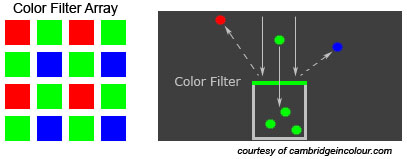
All current sensors except one use Bayer technology. The sensor consists of X megapixels, or light gathering cavities. The sensor is covered with a Bayer array, which is a series of microlenses that allow only certain colors to fall in certain cavities (or pixels). The microlenses are arranged in a defined grid that consists of alternating red-green and green-blue filters.
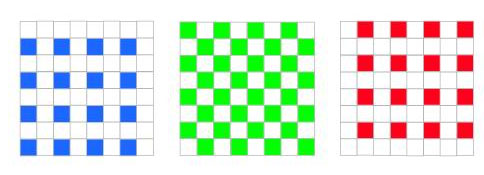
If you noticed there are twice as many green as red or blue areas in the above image, that is by design in the Bayer array. The human eye is more sensitive to green light than red or blue and the Bayer array uses this fact to produce images that appear to have finer detail and less noise. The doubling of the green receptors is corrected in the image processing.
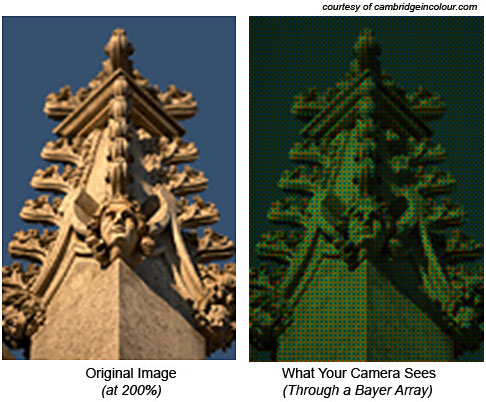
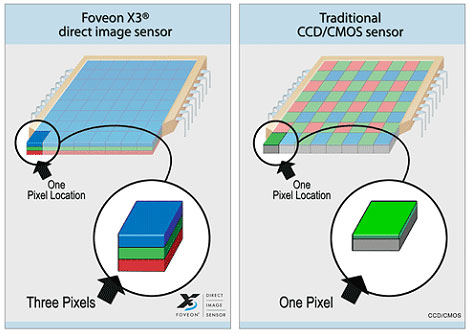
There is no demosaicing or interpolation step with the Foveon sensor. Where before there was one pixel of color information, the Foveon is now capturing red, green, and blue data pixels in the same pixel location. On the surface, this certainly appears a superior way of capturing color images, but things are not always as they appear. It is fair to ask: if this approach is so good then why is Sigma, a minor player in the digital camera market, the only company to embrace the Foveon sensor? A closer look at Foveon specs helps to understand some of the issues.
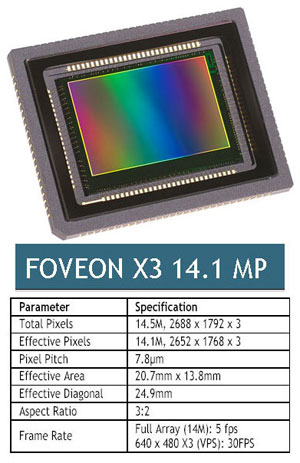
The top current Foveon sensor is the 14.1MP Foveon used in the Sigma SD14 digital camera. Foveon gets to the 14.1MP total by counting all pixels used to create the finished image, which is 2688x1768 pixels or 4.7MP. Many would argue this is fair since each pixel in a competing 14.1MP is only collecting one piece of color information. However, the practical reality is that a 14.1MP Foveon is reported to be about equivalent to an 8MP Bayer DSLR when shooting JPEGs and about as good a 10MP camera when shooting in the preferred and native RAW mode. The apparent resolution then is somewhere between the 4.7MP image size and the 14.1MP that are used to create that image.
Several other issues have also held back Foveon. Where the best Bayer cameras can now capture useful images at ISO 1600, 3200, or even higher, the Foveon sensor is best at lower ISOs. It is usable to about ISO 400 and then noise climbs rapidly as the ISO increases. The latest SD14 Foveon is reported to be better in ISO sensitivity, but it still falls far short of the extended ISO performance of its competition.
The other major issue with the Foveon sensor is that the separation into 3 distinct colors for each pixel site is not nearly as straightforward as Foveon describes it. The captured image still requires a lot of image processing to extract the 3 colors from each pixel site and reconstruct the finished image. In fact some critics claim the image processing required by the Foveon sensor is even more extensive than Bayer Array demosaicing. The purer the data in any extraction process the more faithful it is to the original capture, so the Foveon sensor may offer fewer "post-processing" advantages than it first appears. When conditions and lighting are correct the Foveon can deliver stunning images, but things in photography are rarely perfect.
For the purpose of our discussion the Foveon is more a novelty than a sensor you will likely use today. Despite its limited availability, however, the concept of the Foveon sensor is as compelling as ever, and you can actually buy a production camera, the Sigma SD14, that uses this sensor. As you can see from the specs, the sensor size is 20.7x13.8mm, which places the Foveon between the Canon small APS C and the Olympus 4/3 sensor. The lens multiplier is 1.7X.










72 Comments
View All Comments
melgross - Monday, April 21, 2008 - link
The smaller process technology will have no positive effect on the sensors themselves, though it will for the associated electronics integrated on the die.The same problems he mentioned about smaller sensing sites will remain. The smaller the sensor, the poorer the performance viz a viz larger sensors.
He did mention that the photo division was the purchase, not the entire company (unless he changed the article after your post).
Wesley Fink - Monday, April 21, 2008 - link
I changed the wording on the Sony purchase a bit to better reflect that Sony bought the Minolta camera assets of KM and not the company. Thanks for pointing this out.finbarqs - Monday, April 21, 2008 - link
Canon's 1DS MK2 was a 16.7MP CMOS sensor also, and of course, the MK3 is a 21MP CMOS sensor...Where i'm lost is if CCD's are so much better (in IQ) why dont' they stick with CCD's? why the move to CMOS besides the lower cost and the battery life that it saves?
Why are professional level DSLR's (From canon and Nikon) are both CMOS when we know that CCD is the way to go for better IQ?
melgross - Monday, April 21, 2008 - link
It USED to be true that CCD's were better. Not so any longer. The best CMOS sensors are better than the CCD's they replace.The desire to go CMOS is obvious to the manufacturers of the sensors.
CCD sensor technology is a completely different manufacturing process from that of CMOS, which the entire industry uses for everything else (almost).
Moving to that allows CMOS sensors to not only be able to integrate other electronics on the sensor chip, resulting in simplicity, price advantages, and the ability to more favorably utilize their process lines, but that higher quality you're concerned about.
Putting functions on the same chip improves the quality of the signals.
And, by the way, an error in the article: Canon was not the first to make, or use, a CMOS sensor. They were the first to come out with a high quality sensor. I believe that it was Vivitar that used the first one, though I forgot the name of the manufacturer.
Anther omission is that there are trilinear sensors used in camera backs such as the Betterlight scanning backs. So there are three different major technologies in use.
And not all of the negatives of the Foveon chip was mentioned.
s12033722 - Monday, April 21, 2008 - link
No, CCD is definitely still the IQ king. CCD still has a far better SNR than any CMOS technology.As a digital camera design engineer, I deal with image sensors every day. The major reasons why CMOS sensors are attractive are all cost related. Not only are CMOS sensors themselves cheaper, but they lend themselves to integration with other electronics better and they are MUCH nicer to design with. A typical CMOS sensor will require ground, 3.3V, and maybe some other standard voltages (1.8V, 2.5V, etc.), whereas a typical CCD will require ground and anything from 8 to 12 other DC voltage rails. For instance, I am working on a camera that requires -15V, -9V, -6V, -4V, -1.5V, ground, 2V, 3.5V, 11 V, 15V, 24.5V, and has a clock signal that must run up to 40V. While making the voltages and driving clocks at them is fairly straightforward, it requires a lot more components than a CMOS sensor design would. More components directly equals higher cost. Also, as the article mentions, more functions can be integrated onto CMOS sensors than CCDs.
The other advantage of CMOS vs. CCD is in random-access readout. If you want to read a small region of interest on a CCD, you either have to read out the whole frame and digitally ignore the parts you don't care about (no increase in read speed) or the chip has to support charge dumping, where portions of the image can be dropped without reading them out. CMOS makes it much easier to read small portions of the image, and thus things like live view are simply done.
Lastly, I'd like to mention an issue with the Foveon sensor that the article didn't mention. While the foveon technology presents itself as having three discrete pixels stacked on top of each other, the reality is much more ambiguous. Foveon relies on the ability of different wavelengths of light (colors) to penetrate to different levels in silicon, however, far from being discrete, easily separated regions, the depth of capture of different wavelengths in silicon tends to be very blurry and ill defined. This results in significant color mixing in the foveon design. They manage to pull out the images they do through the use of extensive processing. That makes the technology pretty unappealing to design with, thus the dominance of Bayer sensors. Honestly, if I needed to do a camera with true RGB per pixel, I would use a 3-CCD design where a full sensor is dedicated to each color rather than using anything like a foveon. It would be more expensive, but far better quality.
Wesley Fink - Tuesday, April 22, 2008 - link
Thank you for clarifying several points from the Design Engineer perspective. I appreciate your insights into the CCD vs. CMOS issues.Sometimes it is difficult for people to wrap their heads around the idea that a technology (CMOS) is not the low noise champion, but that it is winning nonetheless because of other attributes such as lower cost, manufacturing efficiency, lower cost, integration advantages, lower cost, lower power consumption, and lower cost. Your comments put that reality into perspective.
melgross - Monday, April 21, 2008 - link
That's all very interesting, but unless you are designing a very high IQ, special purpose (read, very expensive) device, that's simply not an assumption that can be made..CCD's have numerous problems. High power requirements, which lead to higher temperatures, which leads to higher noise levels, requires cooling for the best results, and so on.
There is no inherent IQ advantage to CCD's. The longer development time led to an early start, and all the advantages accrued from that. But that lead shrunk.
Also, when talking about cost/performance, we must realize that it is very important to not lose sight of the fact that performance must be compared at reasonable cost levels. NASA can afford to spend a million for a sensor, which they do, but it's irrelevant to everyone else.
As for the Foveon chip, yes, that is one of the problems I was talking about, and the biggest one.
Some enthusiastic reviews and articles have taken Foveon's word that they undergo little processing compared to Bayer chips. That's only true in the de-matrixing area, and so they don't need a the aliasing filter. But the color mixing problems are just as serious, and I've found, in using the camera, that color quality is more variable than with my 5D. Often noticeably poorer as well.
7thSerapHim - Monday, April 21, 2008 - link
As stated on the Canon CMOS Technology page, it says that although CCD sensors achieve high IQ, they are have slow data-reading speed, which means that it wouldn't be capable to capture at a fast FPS mode.CMOS is capable of high data-reading speed, but due to crosstalk (between pixels) the IQ suffers as a result. However, due to developments in CMOS technology, we can assume that IQ has improved closer to CCD.
My opinion is that the cost, speed, battery life and potential for improvements is what compelled many to adopt CMOS instead of CCD.
Zak - Monday, April 21, 2008 - link
I've recently bought Canon 40D that uses CMOS (right?) and I'm a bit disappointed in the image quality over my Rebel XTi (dead). There is definitely much less noise and it's incredibly fast, but I just can't get images to be as sharp as with the XTi. In particular with 100mm Canon macro lens. I don't know if I got a defective body or the CMOS sensor is indeed softer than CCD in the XTi. I'm considering returning the 40D and fixing my XTi instead.Z.
strikeback03 - Tuesday, April 22, 2008 - link
Canon typically tunes the JPEGS from the entry-level bodies to be more "punchy" (more saturation, more sharpening, more contrast) than on higher-level bodies, to provide results closer to the average P&S output.If RAW, might just be processing variations between RAW profiles for different bodies. Have you tried some sharpening in photoshop or similar to compare images?
Also possible the body is missing focus, but before jumping to that conclusion I'd try the image adjustments first.